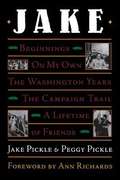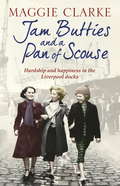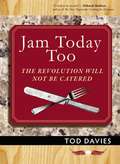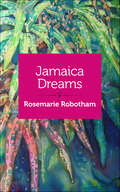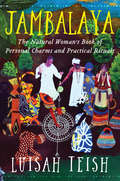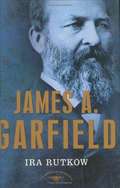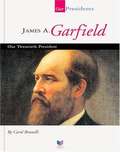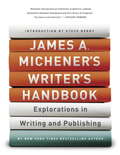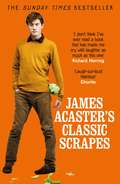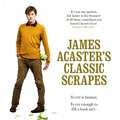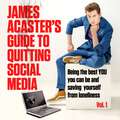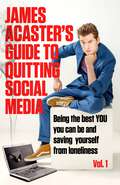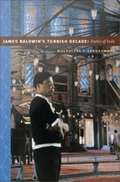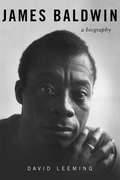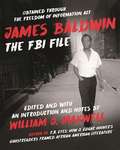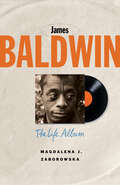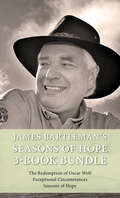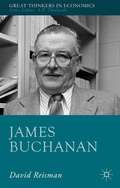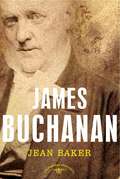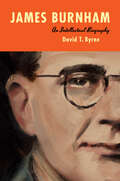- Table View
- List View
Jake
by Jake Pickle Peggy Pickle"My life has been given special purpose," Jake Pickle says. "Some men live to make money, drink, chase women, collect art, excel at a sport, or pursue other things that give them pleasure. The thing I got hooked on was helping people. And I've had the privilege of helping people by the thousands. Serving in Congress was the greatest honor of my life."<P><P>In this book, Jake Pickle tells the story of a lifetime in public service, including thirty-one years as Representative for Texas' Tenth Congressional District. Jake tells his story by telling stories—most of them humorous, some poignant—that add up to a warmly personal account of his life and career.
Jam Butties and a Pan of Scouse
by Cathryn Kemp Maggie ClarkeJAM BUTTIES AND A PAN OF SCOUSE is a gritty yet heart-warming memoir set against the backdrop of Liverpool's tightknit working-class docklands community. The story covers Maggie Clarke's upbringing in the tenements close to the docks, the River Mersey and the Leeds and Liverpool Canal: an area notorious for having the worst slums in Britain, yet the closest community as well.At the tender age of 11, Maggie Clarke finds herself the matriarch of the family when her Irish mother runs off with another man. Leaving school at 14 to work at a local factory putting sticks into lollies, she is determined to make a better life for herself and her family - before starting her own family with her childhood sweetheart, who she marries at 19 after 'falling in the family way'. She has one night of married life with her husband before he is sent to India with the Navy and is devastated when she never hears from him again, presuming him a casualty of the war that is raging at home and abroad. Another tragedy strikes when Maggie's brother Tommy is also claimed by the war, leaving her father inconsolable, but Maggie knows life has to go on and falls in love with Joseph, an Irish settler who she has 8 children with. But her happiness is short-lived as her first husband suddenly appears out of the blue demanding a divorce, and her new husband drinks away what little money they have, returning in fits of rage that leave Maggie and her children hungry and afraid. Many times she is only able to feed her brood by the kindness of neighbours putting a 'pan of scouse' on the range for her, or feeding her kids jam butties to help out. Maggie's story sweeps across the changing face of Liverpool, from its squalid dock streets, the tenement blocks and cobbled roads to the decline of the docklands, new council housing, the rise of the Mersey beat, the Beatles and the energy and passion of a city that is home to a cast of colourful characters with the resilience to withstand the heartbreak and hardships that only the poorest can know.
Jam Today Too
by Tod Davies"A book to be savored." -DEBORAH MADISON, author of The New Vegetarian Cooking for Everyone"Laughing with Tod at her loves and disasters will make you laugh at your own, and keep cooking." -ANNA THOMAS, author of Love Soup and The New Vegetarian Epicure"Chatty, wise, and terrifically useful, Tod Davies' second serving of Jam makes disaster delicious and success the stuff of everyday life. What a treat to read and eat." -KATE LEBO, author of A Commonplace Book of PieWarm, conversational, and exquisitely practical, Davies returns to the Jam Today series to share new recipes from her home kitchen-and stories about her experiences cooking for herself and her friends, family, and pets-during the best and worst of times. Whether she's describing how she set up her kitchen in an RV after a flood, encouraging young feminists to try cooking a baked potato, adapting an M.F.K. Fisher recipe to create "the world's simplest hollandaise sauce," or singing the praises of her favorite local food purveyors, her infectious enthusiasm provides inspiration for everyone from trained chefs to those barely able to scramble an egg.Featuring advice for omnivores and vegetarians alike about how to eat (and what to prepare) to survive natural disasters, cross-country moves, bereavement, holidays-gone-wrong, and even a spontaneous picnic, Jam Today Too provides all the ingredients for daily feeding of mind, body, and soul.Tod Davies is the author of Snotty Saves the Day and Lily the Silent, both from The History of Arcadia series, and the cooking memoirs Jam Today: A Diary of Cooking With What You've Got and Jam Today Too: The Revolution Will Not Be Catered. Unsurprisingly, her attitude toward literature is the same as her attitude toward cooking-it's all about working with what you have to find new ways of looking and new ways of being, and in doing so, to rediscover the best of our humanity. Davies lives with her husband and their two dogs, in the alpine valley of Colestin, Oregon, and at the foot of the Rocky Mountains, in Boulder, Colorado.
Jamaica Dreams: A Memoir
by Rosmarie RobothamIn this memoir of adolescence in Kingston, Jamaica, the daughter of a sprawling family raised in relative privilege explores the secret sense of exile that fuels her dreams of a new life in a foreign place. Along the way she falls in love with a lonely girl who lives at the orphanage up the street from her school; finds her calling in a grandparent’s imperious command; wrestles with the emotions that attend the drinking of her father, a good and moral man with a weakness for the bottle; and decides to give up her virginity to a boy she meets after school. Rosemarie Robotham’s coming-of-age tale takes us inside middle-class life in Jamaica at a time when an exciting new political movement is sweeping the island and everything seems fraught with danger, yet thrillingly possible.
Jambalaya: The Natural Woman's Book of Personal Charms and Practical Rituals
by Luisah TeishA refreshed edition of Jambalaya: The Natural Woman’s Book of Personal Charms and Practical Rituals—updated with a note from the author sharing the changes that have occurred in the 30 years since its original publication. "A book of startling remembrances, revelations, directives, and imperatives, filled with the mysticism, wisdom, and common sense of the African religion of the Mother. It should be read with the same open-minded love with which it was written."—Alice Walker, author of The Color PurpleSince its original publication in 1985, Jambalaya has become a classic among Women’s Spirituality Educators, practitioners of traditional Africana religions, environmental activists, and cultural creatives. A mix of memoir, spiritual teachings, and practices from Afro-American traditions such as Ifa/Orisha, and New Orleans Voudou, it offers a fascinating introduction to the world of nature-based spirituality, Goddess worship, and rituals from the African diaspora. More relevant today than it was 36 years ago, the wisdom of Jambalaya reconnects us to the natural and spiritual world, and the centuries-old traditions of African ancestors, whose voices echo through time, guiding us and blending with our own.
James A. Garfield (The American Presidents Series)
by Ira M. RutkowThe ambitious self-made man who reached the pinnacle of American politics--only to be felled by an assassin's bullet and to die at the hands of his doctors. James A. Garfield was one of the Republican Party's leading lights in the years following the Civil War. Born in a log cabin, he rose to become a college president, Union Army general, and congressman-all by the age of thirty-two. Embodying the strive-and-succeed spirit that captured the imagination of Americans in his time, he was elected president in 1880. It is no surprise that one of his biographers was Horatio Alger.Garfield's term in office, however, was cut tragically short. Just four months into his presidency, a would-be assassin approached Garfield at the Washington, D.C., railroad station and fired a single shot into his back. Garfield's bad luck was to have his fate placed in the care of arrogant physicians who did not accept the new theory of antisepsis. Probing the wound with unwashed and occasionally manure-laden hands, Garfield's doctors introduced terrible infections and brought about his death two months later. Ira Rutkow, a surgeon and historian, offers an insightful portrait of Garfield and an unsparing narrative of the medical crisis that defined and destroyed his presidency. For all his youthful ambition, the only mark Garfield would make on the office would be one of wasted promise.
James A. Garfield: Our Twentieth President
by Carol BrunelliA thorough, illustrated biography discussing the president's childhood, his career, his family, and his term as President of the United States. Includes a time line and glossary.
James A. Michener's Writer's Handbook
by James A. Michener Steve BerryPulitzer Prize-winning author James A. Michener has written about everything from the pristine islands of the South Pacific and the endless wilds of Africa to Spanish bullfighters, American revolutionaries, and pirates of the Caribbean. Now Michener turns to his favorite and most personal subject: the written word. Reproducing pages from his own handwritten rough drafts and working manuscripts, Michener walks the reader through a step-by-step guide to the entire process of writing, editing, revising, and publishing. Addressing challenges specific to both fiction and nonfiction, all the while providing thoughtful and useful solutions, James A. Michener's Writer's Handbook is an invaluable resource for book lovers, editors, and, of course, writers--aspiring and accomplished alike.
James Acaster's Classic Scrapes - The Hilarious Sunday Times Bestseller
by James Acaster**THE SUNDAY TIMES BESTSELLER**'I don't think I've ever read a book that has made me cry with laughter as much as this one. It was very difficult reading it in public as I looked like a madman' - Richard Herring James Acaster has been nominated for the Edinburgh Comedy Award five times and has appeared on prime-time TV shows like TASKMASTER,MOCK THE WEEK, LIVE AT THE APOLLO and WOULD I LIE TO YOU?But behind the fame and critical acclaim is a man perpetually getting into trouble. Whether it's disappointing a skydiving instructor mid-flight, hiding from thugs in a bush wearing a bright red dress, or annoying the Kettering Board Games club, a didgeridoo-playing conspiracy theorist and some bemused Christians, James is always finding new ways to embarrass himself.Appearing on Josh Widdicombe's radio show to recount these stories, the feature was christened 'James Acaster's classic scrapes'. Here, in his first book, James recounts these tales (including never-before-heard stories) along with self-penned drawings, in all their glorious stupidity.
James Acaster's Classic Scrapes - The Hilarious Sunday Times Bestseller
by James Acaster**THE SUNDAY TIMES BESTSELLER**'I don't think I've ever read a book that has made me cry with laughter as much as this one. It was very difficult reading it in public as I looked like a madman' - Richard Herring James Acaster has been nominated for the Edinburgh Comedy Award five times and has appeared on prime-time TV shows like TASKMASTER, MOCK THE WEEK, LIVE AT THE APOLLO and WOULD I LIE TO YOU?But behind the fame and critical acclaim is a man perpetually getting into trouble. Whether it's disappointing a skydiving instructor mid-flight, hiding from thugs in a bush wearing a bright red dress, or annoying the Kettering Board Games club, a didgeridoo-playing conspiracy theorist and some bemused Christians, James is always finding new ways to embarrass himself.Appearing on Josh Widdicombe's radio show to recount these stories, the feature was christened 'James Acaster's classic scrapes'. Here, in his first book, James recounts these tales (including never-before-heard stories) along with self-penned drawings, in all their glorious stupidity.
James Acaster's Classic Scrapes - The Hilarious Sunday Times Bestseller
by James Acaster**THE SUNDAY TIMES BESTSELLER** 'I don't think I've ever read a book that has made me cry with laughter as much as this one. It was very difficult reading it in public as I looked like a madman' - Richard Herring 'James Acaster has a brilliant comic mind, crackling with energy every bit as much as his corduroy slacks' - Milton JonesJames Acaster has been nominated for the Edinburgh Comedy Award five times and has appeared on prime-time TV shows like MOCK THE WEEK, LIVE AT THE APOLLO and RUSSELL HOWARD'S STAND UP CENTRAL.But behind the fame and critical acclaim is a man perpetually getting into trouble. Whether it's disappointing a skydiving instructor mid-flight, hiding from thugs in a bush wearing a bright red dress, or annoying the Kettering Board Games club, a didgeridoo-playing conspiracy theorist and some bemused Christians, James is always finding new ways to embarrass himself.Appearing on Josh Widdicombe's radio show to recount these stories, the feature was christened 'James Acaster's classic scrapes'. Here, in his first book, James recounts these tales (including never-before-heard stories) along with self-penned drawings, in all their glorious stupidity.(P)2017 Headline Publishing Group Ltd
James Acaster's Guide to Quitting Social Media
by James AcasterThis is a self help book like no other. Because you are not helping yourself, James Acaster is helping you.When James quit all forms of social media in 2019 he felt like he'd been born anew, but he was worried he'd suffer withdrawal and get lured back online to compete in a never ending popularity contest with only one possible winner (f*cking Zuckerberg). He knew that in order to stay clean he'd have to replace everything social media used to give him with three-dimensional, real-life activities. And so it was that James found ways to anonymously bully strangers, see photos of everyone's dogs, get invited to as many parties as possible, immediately know about all celebrity deaths, get public figures fired, argue with everybody about everything, and so much more without even owning a phone (he painted over the screen of his old one to stop himself looking at Instagram). His life is amazing and yours could be too if you buy JAMES ACASTER'S GUIDE TO QUITTING SOCIAL MEDIA, BEING THE BEST YOU YOU CAN BE AND SAVING YOURSELF FROM LONELINESS VOL. 1. You will also need to do everything the audiobook tells you to. Including helping us promote the audiobook by tweeting about it.(P) 2022 Headline Publishing Group Ltd
James Acaster's Guide to Quitting Social Media
by James AcasterThis is a self-help book like no other. Because you are not helping yourself, James Acaster is helping you.In 2019, James quit all forms of social media - covering his phone in tar and driving it to a lock-up in Rhyl, before setting up home in a castle he'd built himself called Castle Anti-Net. But when the withdrawal symptoms hit him, he realised in order to stay clean he'd have to replace everything social media gave him with three-dimensional, real-life activities. Employing the help of a mysterious, wealthy benefactor named Clancy Dellahue, and an ever-growing gang of misfits (aka the Tangfastic Crew), James found ways to replace his online friends (he joined the scouts) and spy on his exes (climbing ropes, zip lines, fake moustache) as well as anonymously bullying strangers, seeing photos of everyone's dogs, getting public figures fired, arguing with everybody about everything, and so much more. His life is amazing and yours could be too if you buy JAMES ACASTER'S GUIDE TO QUITTING SOCIAL MEDIA, BEING THE BEST YOU YOU CAN BE AND SAVING YOURSELF FROM LONELINESS VOL. 1.
James Acaster's Guide to Quitting Social Media
by James AcasterThis is a self-help book like no other. Because you are not helping yourself, James Acaster is helping you.In 2019, James quit all forms of social media - covering his phone in tar and driving it to a lock-up in Rhyl, before setting up home in a castle he'd built himself called Castle Anti-Net. But when the withdrawal symptoms hit him, he realised in order to stay clean he'd have to replace everything social media gave him with three-dimensional, real-life activities. Employing the help of a mysterious, wealthy benefactor named Clancy Dellahue, and an ever-growing gang of misfits (aka the Tangfastic Crew), James found ways to replace his online friends (he joined the scouts) and spy on his exes (climbing ropes, zip lines, fake moustache) as well as anonymously bullying strangers, seeing photos of everyone's dogs, getting public figures fired, arguing with everybody about everything, and so much more. His life is amazing and yours could be too if you buy JAMES ACASTER'S GUIDE TO QUITTING SOCIAL MEDIA, BEING THE BEST YOU YOU CAN BE AND SAVING YOURSELF FROM LONELINESS VOL. 1.
James Baldwin's Turkish Decade: Erotics of Exile
by Magdalena J. ZaborowskaBetween 1961 and 1971 James Baldwin spent extended periods of time in Turkey, where he worked on some of his most important books. In this first in-depth exploration of Baldwin's "Turkish decade," Magdalena J. Zaborowska reveals the significant role that Turkish locales, cultures, and friends played in Baldwin's life and thought. Turkey was a nurturing space for the author, who by 1961 had spent nearly ten years in France and Western Europe and failed to reestablish permanent residency in the United States. Zaborowska demonstrates how Baldwin's Turkish sojourns enabled him to re-imagine himself as a black queer writer and to revise his views of American identity and U. S. race relations as the 1960s drew to a close. Following Baldwin's footsteps through Istanbul, Ankara, and Bodrum, Zaborowska presents many never published photographs, new information from Turkish archives, and original interviews with Turkish artists and intellectuals who knew Baldwin and collaborated with him on a play that he directed in 1969. She analyzes the effect of his experiences on his novel Another Country (1962) and on two volumes of his essays, The Fire Next Time (1963) and No Name in the Street (1972), and she explains how Baldwin's time in Turkey informed his ambivalent relationship to New York, his responses to the American South, and his decision to settle in southern France. James Baldwin's Turkish Decade expands the knowledge of Baldwin's role as a transnational African American intellectual, casts new light on his later works, and suggests ways of reassessing his earlier writing in relation to ideas of exile and migration.
James Baldwin: A Biography
by David LeemingJames Baldwin was one of the great writers of the last century. In works that have become part of the American canon-Go Tell It on a Mountain, Giovanni’s Room, Another Country, The Fire Next Time, and The Evidence of Things Not Seen-he explored issues of race and racism in America, class distinction, and sexual difference. A gay, African American writer who was born in Harlem, he found the freedom to express himself living in exile in Paris. When he returned to America to cover the Civil Rights movement, he became an activist and controversial spokesman for the movement, writing books that became bestsellers and made him a celebrity, landing him on the cover of Time.In this biography, which Library Journal called "indispensable,” David Leeming creates an intimate portrait of a complex, troubled, driven, and brilliant man. He plumbs every aspect of Baldwin’s life: his relationships with the unknown and the famous, including painter Beauford Delaney, Richard Wright, Lorraine Hansberry, Marlon Brando, Harry Belafonte, Lena Horne, and childhood friend Richard Avedon; his expatriate years in France and Turkey; his gift for compassion and love; the public pressures that overwhelmed his quest for happiness, and his passionate battle for black identity, racial justice, and to "end the racial nightmare and achieve our country.”Skyhorse Publishing, along with our Arcade, Good Books, Sports Publishing, and Yucca imprints, is proud to publish a broad range of biographies, autobiographies, and memoirs. Our list includes biographies on well-known historical figures like Benjamin Franklin, Nelson Mandela, and Alexander Graham Bell, as well as villains from history, such as Heinrich Himmler, John Wayne Gacy, and O. J. Simpson. We have also published survivor stories of World War II, memoirs about overcoming adversity, first-hand tales of adventure, and much more. While not every title we publish becomes a New York Times bestseller or a national bestseller, we are committed to books on subjects that are sometimes overlooked and to authors whose work might not otherwise find a home.
James Baldwin: The FBI File
by William J. MaxwellAvailable in book form for the first time, the FBI's secret dossier on the legendary and controversial writer. Decades before Black Lives Matter returned James Baldwin to prominence, J. Edgar Hoover’s FBI considered the Harlem-born author the most powerful broker between black art and black power. Baldwin’s 1,884-page FBI file, covering the period from 1958 to 1974, was the largest compiled on any African American artist of the Civil Rights era. This collection of once-secret documents, never before published in book form, captures the FBI’s anxious tracking of Baldwin’s writings, phone conversations, and sexual habits?and Baldwin’s defiant efforts to spy back at Hoover and his G-men.James Baldwin: The FBI File reproduces over one hundred original FBI records, selected by the noted literary historian whose award-winning book, F.B. Eyes: How J. Edgar Hoover’s Ghostreaders Framed African American Literature, brought renewed attention to bureau surveillance. William J. Maxwell also provides an introduction exploring Baldwin's enduring relevance in the time of Black Lives Matter along with running commentaries that orient the reader and offer historical context, making this book a revealing look at a crucial slice of the American past?and present.
James Baldwin: The Last Interview
by James Baldwin Quincy TroupeNever before available, the unexpurgated last interview with James Baldwin"I was not born to be what someone said I was. I was not born to be defined by someone else, but by myself, and myself only." When, in the fall of 1987, the poet Quincy Troupe traveled to the south of France to interview James Baldwin, Baldwin's brother David told him to ask Baldwin about everything--Baldwin was critically ill and David knew that this might be the writer's last chance to speak at length about his life and work.The result is one of the most eloquent and revelatory interviews of Baldwin's career, a conversation that ranges widely over such topics as his childhood in Harlem, his close friendship with Miles Davis, his relationship with writers like Toni Morrison and Richard Wright, his years in France, and his ever-incisive thoughts on the history of race relations and the African-American experience.Also collected here are significant interviews from other moments in Baldwin's life, including an in-depth interview conducted by Studs Terkel shortly after the publication of Nobody Knows My Name. These interviews showcase, above all, Baldwin's fearlessness and integrity as a writer, thinker, and individual, as well as the profound struggles he faced along the way.
James Baldwin: The Life Album (Black Lives)
by Magdalena J. ZaborowskaAn intimate portrait of James Baldwin, offering a new understanding of his life and works as seen through his close relationships and private life James Baldwin (1924–1987) was a pivotal figure of the twentieth century, an influential author, intellectual, and activist who led a celebrated public life—and whose words and image and persona remain current in our culture. Baldwin&’s many incarnations—&“son of Harlem,&” &“Black icon,&” &“great twentieth-century writer,&” &“race man,&” &“prophet,&” &“witness&”—have reemerged in the digital age as Baldwin&’s work becomes a touchstone for a new generation. It is the private, vulnerable, and messier Baldwin—the man behind the prophet and the online meme—who is the focus of this book. Magdalena J. Zaborowska draws on Baldwin&’s archives and material legacy—from his unpublished papers to his books to his house in France—to offer a fresh look at the writer&’s understated and obscured private life. Taking a cue from Baldwin&’s own love of the blues, Zaborowska presents his biography as a series of tracks on a vinyl record, introducing, developing, and remixing the themes and relationships from his life. She recounts episodes from Baldwin&’s troubled childhood, his struggles with sexuality and gender, his intimate relationships, and the overlooked influence of women, Jews, and queers on his writing. This Life Album revolves around Baldwin&’s development of a unique worldview, &“Black queer humanism,&” premised on African diaspora aesthetics, resilience, joy, community, internationalism, activism, and justice.
James Bartleman's Seasons of Hope 3-Book Bundle: Seasons of Hope / Exceptional Circumstances / The Redemption of Oscar Wolf
by James BartlemanNovelist, diplomat, statesman, representative of both the First Nations and the Crown in Canada, James Bartleman always writes from his incredible personal experience. Presented here are three extraordinary books, each touching on a different aspect of his life, whether a candid tell-all about the halls of power, or his unique novels in which the names and details have been changed to protect the innocent. Guaranteed to captivate readers of all stripes. Includes: Seasons of Hope Traces James Bartleman's life from an impoverished Native childhood to being appointed ambassador for Canada and lieutenant governor for Ontario, and how as his career advanced, he mobilized public support for Native education. This story traces the whole amazing story. Exceptional Circumstances When Luc Cadotte, diplomat and spy, returns home from Latin America during the FLQ Crisis, he becomes entangled in political machinations and a story of espionage, betrayal, and love gone wrong. Facing an unprecedented wave of domestic terrorism, Cadotte must weigh his ethics against public safety, with lives on the line. The Redemption of Oscar Wolf A saga of mid-20th-century Native life in Canada and abroad, and a novel of resonating ideas and unforgettable characters, whose fascinating, anti-hero protagonist sets out on a quest for redemption after a terrible incident kills his grandfather and a young maid.
James Buchanan
by David ReismanJames Buchanan (1919-2013) was awarded the Nobel Prize in Economics in 1986 for his synthesis of market economics and political democracy. A libertarian, a contractarian, a constitutionalist, Buchanan saw the social world as a network of individuals revealing preferences and negotiating exchanges. Self-interest that might otherwise have led to the war of each against all is channelled into the division of labour and capitalism by consent. Trade gives rational individuals the opportunity to increase each other's felt well-being. Gain-seeking anarchy is the economist's utopia but still a protective State is needed to ensure that agreements are honoured and the rules obeyed. Buchanan made himself a missionary for binding agreements and good rules. Without them, he warned, we would surely fight. Using morals when other economists used mathematics, Buchanan argued a market economist's case for tolerance of diversity, unanimity of consensus and uncompromising respect. This book, James Buchanan, seeks to explain and evaluate the thought-provoking insights of a prolific and original thinker who enriched the ethical aspirations of a frequently dismal science.
James Buchanan (The American Presidents Series)
by Jean H. Baker Arthur M. Schlesinger Jr.Almost no president was as well trained and well prepared for the office as James Buchanan. He had served in the Pennsylvania state legislature, the U.S. House, and the U.S. Senate; he was Secretary of State and was even offered a seat on the Supreme Court. And yet, by every measure except his own, James Buchanan was a miserable failure as president, leaving office in disgrace. Virtually all of his intentions were thwarted by his own inability to compromise: he had been unable to resolve issues of slavery, caused his party to split-thereby ensuring the election of the first Republican president, Abraham Lincoln--and made the Civil War all but inevitable. Historian Jean H. Baker explains that we have rightly placed Buchanan at the end of the presidential rankings, but his poor presidency should not be an excuse to forget him. To study Buchanan is to consider the implications of weak leadership in a time of national crisis. Elegantly written, Baker's volume offers a balanced look at a crucial moment in our nation's history and explores a man who, when given the opportunity, failed to rise to the challenge.
James Buchanan: Fifteenth President Of The United States
by David R. CollinsPresents the life of James Buchanan, including his childhood, education, employment, and political career.
James Burnham: An Intellectual Biography
by David T. ByrneIn this intellectual biography of one of the most important political thinkers of the twentieth century, David T. Byrne reveals the fascinating life of James Burnham. Beginning his intellectual career as a disciple of Leon Trotsky, Burnham preached socialist revolution to the American working classes during the Great Depression. In 1940 he split with Trotsky over the nature of the USSR. Attempting to explain the world that was emerging in the early days of World War II, Burnham penned one of the most successful political works of the early 1940s, titled The Managerial Revolution. This dystopian treatise predicted collectivization and rule by bland managers and bureaucrats. Burnham's next book, The Machiavellians, argued that political elites seek only to obtain and maintain power, and democracy is best achieved by resisting them.After World War II, Burnham became one of the foremost anticommunists in the United States. His The Struggle for the World and The Coming Defeat of Communism remain two of the most important books of the early Cold War era. Rejecting George F. Kennan's policy of containment, Burnham demanded an aggressive foreign policy against the Soviet Union. Along with William F. Buckley, Burnham helped found National Review magazine in 1955, where he expressed his political views for more than two decades.As Byrne shows in James Burnham, the political theorist's influence has stretched from George Orwell to Ronald Reagan to Donald Trump's base. Burnham's ideas about the elite and power remain part of US political discourse and, perhaps, have more relevance than ever before.
James Cameron: From Truck Driver to Director (Extraordinary Success with a High School)
by Kim EtingoffIn the last few decades, more and more people are going to college to further their education. It's hard to become a scientist, a professor, or a businessperson without getting some sort of college degree--but college isn't always necessary to achieve success. Some people are ready to enter the workforce right after high school. James Cameron was one of these people. The successful director has created some of Hollywood's biggest hits. From "Aliens" to "Avatar", from "Terminator" to "Titantic", Cameron has been making dreams--and nightmares--come to life on screen for decades. And what's most amazing about his story is that the famous filmmaker did it all without a college degree!
